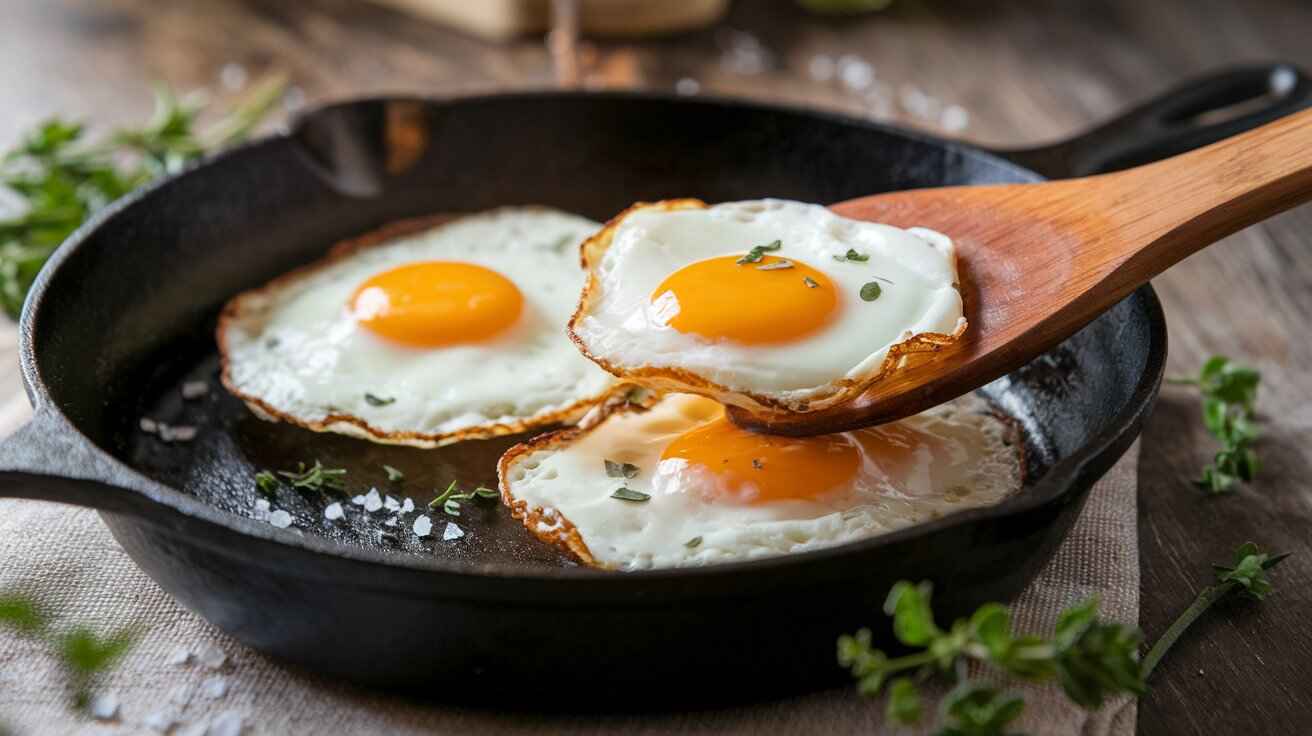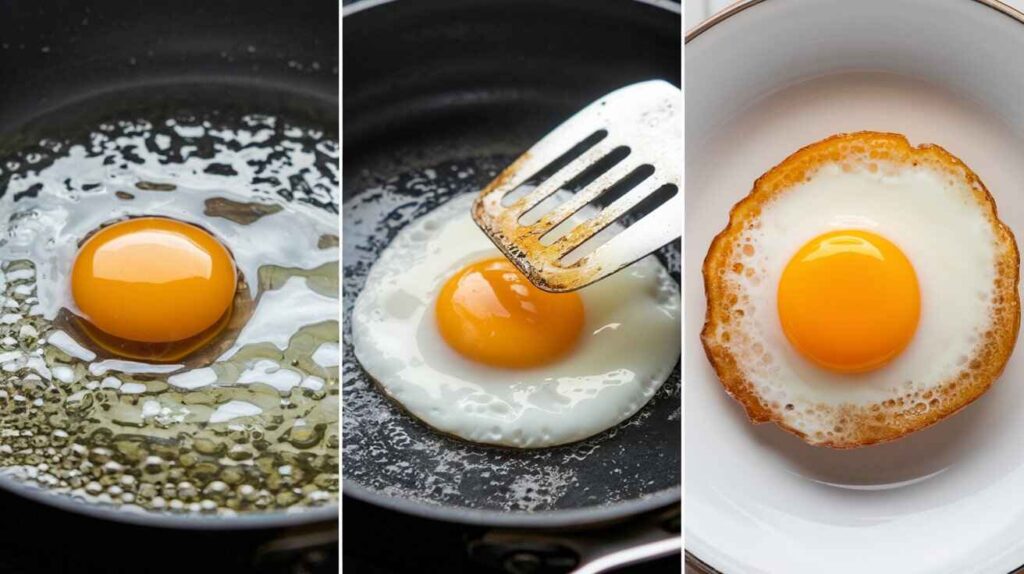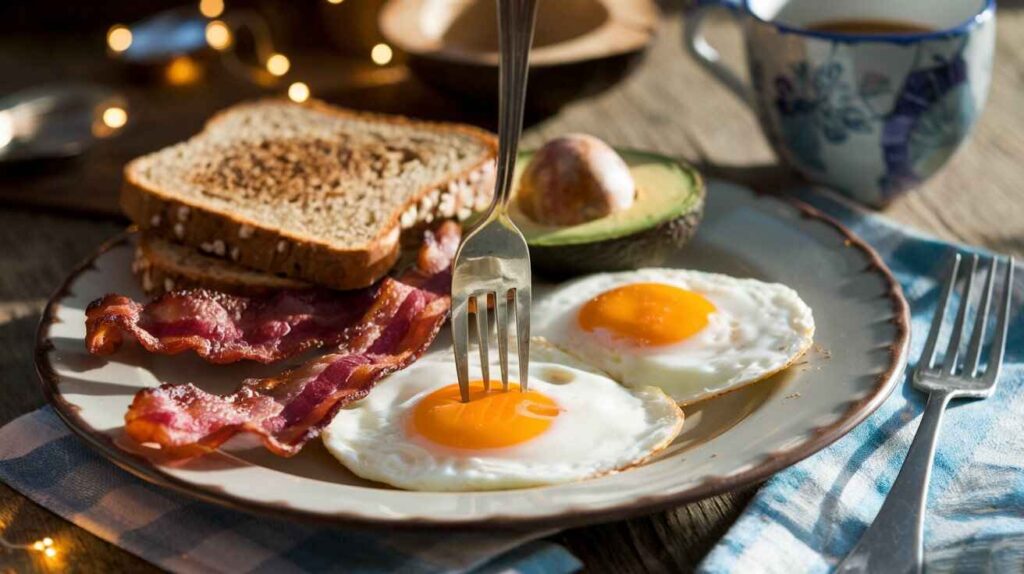Eggs are a breakfast favorite around the world, prized for their versatility in the kitchen. Whether you enjoy them scrambled, poached, or fried, there’s a style for everyone. One often-overlooked but delicious option? Over hard eggs!
In this guide, we’ll cover everything you need to know about over hard eggs—what they are, how they differ from other fried eggs, and expert tips for cooking them to perfection. You’ll also learn the best storage methods, creative serving ideas, and ways to incorporate them into your meals.
Whether you’re new to frying eggs or looking to refine your technique, this article has got you covered.
Let’s get started!
Table of contents

Perfect Over Hard Eggs
Equipment
- Non-stick skillet or cast-iron pan
- Spatula
Ingredients
Main Ingredients
- 2 large eggs fresh
- 1 tsp butter or oil for frying
- salt and black pepper to taste
Instructions
- Heat butter or oil in a non-stick or cast-iron skillet over medium heat.
- Crack the eggs into the pan, keeping them spaced apart.
- Cook until the whites are set and edges start to crisp, about 2 minutes.
- Gently flip the eggs using a spatula. Be careful not to break the yolks.
- Reduce heat slightly and cook another 1–2 minutes until yolks are firm and fully set.
- Season with salt and pepper. Serve hot with toast, salad, or in a breakfast sandwich.
Notes
What Are Over Hard Eggs?
If you love eggs but prefer a firm, fully cooked yolk, this fried egg style is a great choice. Unlike sunny-side-up eggs with their runny yolks, these are flipped and cooked on both sides until the center is fully set. This method creates crispy whites with a firm, non-runny yolk—perfect for those who enjoy a more structured texture.
Understanding Over Hard Eggs
The term over hard refers to an egg that’s been fried, flipped, and cooked until the yolk is firm. This technique results in a well-done egg that’s perfect for breakfast sandwiches, salads, or even as a protein-packed snack.
Difference Between Over Easy, Over Medium, and Over Hard Eggs
Eggs can be cooked in several different ways, each offering a unique texture:
- Over easy – The egg is fried on one side, then flipped and cooked just enough to seal the top while keeping the yolk runny.
- Over medium – After flipping, the yolk is cooked slightly longer, resulting in a soft, jammy center.
- Over hard – The yolk is fully cooked, making it firm and solid all the way through.
Why Choose Over Hard Eggs?
There are several reasons why over hard eggs might be the best choice for you:
Great for those who dislike runny yolks – Some people prefer a fully cooked yolk over a soft or liquidy center.
Perfect for meal prep – They hold their texture well and can be stored easily for later use.
Versatile for various dishes – They can be served solo, in sandwiches, or even on top of salads and stir-fries.
If you’re looking for a simple yet delicious way to enjoy eggs, over hard eggs might just become your new favorite!
How to Make Over Hard Eggs – Step-by-Step Guide
Cooking firm, well-done eggs is simple, but achieving that perfect crispy white with a fully set yolk takes a little technique. Follow this step-by-step guide to get consistently great results every time.
Essential Ingredients for the Best Fried Eggs
To achieve the perfect texture and flavor, you’ll need just a few simple ingredients:
- Eggs – Fresh eggs hold their shape better and cook more evenly.
- Cooking fat – Butter, olive oil, or avocado oil all work well. Butter adds richness, while oil helps create crispier edges.
- Salt and pepper – A little seasoning enhances the natural flavors.
Step-by-Step Cooking Instructions
- Heat the pan – Place a non-stick or cast-iron skillet over medium heat. Add butter or oil and let it melt completely.
- Crack the eggs – Carefully crack an egg into the pan. If cooking multiple eggs, leave space between them so they don’t merge.
- Let the whites set – Allow the egg whites to cook until they turn opaque and start crisping around the edges.
- Flip the egg – Gently slide a spatula under the egg and quickly flip it over. Be careful not to break the yolk.
- Cook until yolk is firm – Reduce the heat slightly and let the egg cook for another 1-2 minutes until the yolk is fully set.
- Season and serve – Sprinkle with salt and pepper, then enjoy immediately.
Common Mistakes and How to Avoid Them
- Cooking on too high heat – This can cause the egg whites to burn while the yolk remains undercooked. Keep the heat at medium.
- Flipping too soon – If the whites aren’t fully set before flipping, they can break apart. Wait until the edges look crispy.
- Using a dry pan – Always use butter or oil to prevent sticking and add extra flavor.
- Breaking the yolk while flipping – Use a wide spatula and flip gently to keep the egg intact.
Expert Tips for the Best Over Hard Eggs
- If you love extra crispy edges, use avocado oil, which has a high smoke point and helps achieve that golden crunch.
- For even cooking, cover the pan with a lid for the last 30 seconds. This helps set the yolk without overcooking the whites.
- Want a richer taste? Use a mix of butter and oil for the best balance of flavor and texture.
Once you master this technique, making over hard eggs will be effortless. They’re quick, foolproof, and a fantastic addition to countless meals.
Best Oils and Fats for Frying Over Hard Eggs
The type of fat you use to cook over hard eggs can make a big difference in flavor, texture, and overall quality. Some fats create crispy edges, while others add richness. Let’s explore the best options.
Butter vs. Olive Oil vs. Avocado Oil – What’s Best?
Different fats bring unique qualities to fried eggs, influencing their flavor, texture, and crispiness. Here’s how some popular options compare:
- Butter – Adds a rich, creamy taste and helps with browning. However, its low smoke point means it can burn quickly over high heat.
- Olive Oil – A heart-healthy choice with a mild, peppery flavor. Best for medium-heat cooking.
- Avocado Oil – With a high smoke point, it allows for crispier edges at higher temperatures while maintaining a neutral flavor.
- Ghee (Clarified Butter) – Retains the rich taste of butter but handles high heat better, making it great for frying.
- Coconut Oil – Imparts a subtle coconut flavor and is an excellent option for paleo or dairy-free diets.
Choosing the Right Cooking Fat for Crispy Edges
If you love crispy-edged over hard eggs, go for oils with a high smoke point like avocado or olive oil. If you prefer a softer texture with a richer taste, butter or ghee is the way to go.
For the best of both worlds, try using half butter, half oil. The butter adds flavor, while the oil prevents burning and helps achieve that perfect crispiness.

Over Hard Eggs in Different Diets – Keto, Paleo, and More
Eggs are a staple in many diets, and over hard eggs work well in a variety of healthy eating plans. Whether you’re following keto, paleo, or a high-protein diet, they provide a nutritious, satisfying option that keeps you full longer.
Are Over Hard Eggs Healthy? Nutritional Benefits
Absolutely! Over hard eggs are rich in protein, essential vitamins, and healthy fats. Each egg provides about 6 grams of protein, making it an excellent choice for those looking to maintain muscle mass and stay full longer. They are also packed with:
- Vitamin B12 – Essential for brain function and energy production.
- Choline – Supports liver health and metabolism.
- Healthy Fats – Helps keep you full and supports hormone balance.
How Over Hard Eggs Fit into Low-Carb and Keto Diets
For those on a low-carb or keto diet, over hard eggs are a fantastic meal choice. Since they contain virtually no carbs, they make an ideal keto-friendly breakfast or snack. Pair them with avocado or cheese for a nutrient-dense, high-fat meal that keeps you in ketosis.
Eggs in a High-Protein Diet
Athletes and fitness enthusiasts often include eggs in high-protein diets for muscle recovery and sustained energy. Since this cooking style provides complete protein, it’s a great addition to any balanced meal plan.
Creative Ways to Serve Over Hard Eggs
While over hard eggs are delicious on their own, they can also be used in countless dishes. Whether you’re making breakfast, lunch, or a quick snack, these eggs add protein and flavor to any meal.
Classic Breakfast Combinations
Start your day with a hearty meal by pairing over hard eggs with:
- Crispy bacon and toast for a traditional breakfast plate.
- Avocado and smoked salmon for a nutrient-packed morning meal.
- Sauteed spinach and mushrooms for a fiber-rich, vegetarian-friendly dish.

Over Hard Eggs on Sandwiches and Burgers
One of the best ways to enjoy over hard eggs is in a sandwich or burger. Since the yolk is fully cooked, there’s no mess—just flavor and texture! Try adding an egg to:
- A breakfast sandwich with cheese and ham on an English muffin.
- A juicy burger for extra protein and a rich, savory taste.
- A grilled chicken wrap for a high-protein, on-the-go meal.
Topping Salads and Grain Bowls with Over Hard Eggs
Chopped over hard eggs make a great topping for:
- Cobb salad – Adds a boost of protein and a satisfying texture.
- Quinoa or rice bowls – Complements grains and roasted veggies.
- Asian stir-fries – A protein-rich addition to veggie-packed dishes.
Using Over Hard Eggs in Meal Prep
Because over hard eggs store well, they are perfect for meal prepping. Make a batch ahead of time and use them throughout the week:
- Slice them up and toss them into salads.
- Pack them as a quick protein snack.
- Add them to a wrap for an easy, healthy lunch.
Storage and Reheating Tips
Once you’ve mastered cooking over hard eggs, knowing how to store and reheat them properly can save you time and keep them tasting great. While they’re best enjoyed fresh, you can still store and reheat them for later use without sacrificing too much texture or flavor.
How to Store Cooked Over Hard Eggs
If you plan to store over hard eggs, follow these simple steps:
- Let them cool completely before storing. Placing hot eggs in a container can trap moisture, making them soggy.
- Use an airtight container to prevent them from absorbing other flavors in the fridge.
- Store for up to two days for the best taste and texture. Any longer, and they might turn rubbery.
Best Methods for Reheating Without Overcooking
Reheating firm, fully cooked eggs the right way ensures they stay flavorful without becoming dry or rubbery. Here are the best methods:
- Stovetop – Warm a non-stick pan over low heat and reheat each side for about 30 seconds.
- Microwave – Place on a microwave-safe plate, cover with a damp paper towel, and heat for 10–15 seconds.
- Oven – If reheating multiple eggs, bake at 300°F (150°C) for 5 minutes to maintain texture.
Frequently Asked Questions
Many people have questions about this fried egg style, especially regarding cooking techniques, nutrition, and variations. Below are answers to some of the most common questions.
What Are Over Hard Eggs?
This type of fried egg is cooked on both sides until the yolk is completely firm. Unlike sunny-side-up or over-easy eggs, it has no runny center. This makes it ideal for those who prefer a fully cooked yolk or need a mess-free option for sandwiches and meal prep.
Can You Fry Eggs in Butter Only?
Yes, but using a combination of butter and oil often works better. Butter adds rich flavor, while oil (such as avocado or olive oil) prevents burning and helps create crispier edges. A mix of both gives you the best results.
How Much Protein Is in a Fully Cooked Egg?
Each large egg provides about 6 grams of protein, making it an excellent high-protein food. It also contains essential nutrients like vitamin B12, iron, and healthy fats, supporting muscle growth, brain function, and overall well-being.
What Are the Different Types of Fried Eggs?
Fried eggs vary based on yolk texture:
- Over Easy – Flipped but with a fully runny yolk.
- Over Medium – The yolk is partially cooked, leaving it slightly jammy.
- Over Hard – The yolk is completely firm and set.
Each style suits different preferences, but fully cooked eggs are great for those who prefer a firmer texture.
Now that these FAQs are covered, you have everything you need to confidently cook, serve, and enjoy this classic breakfast favorite!
Conclusion
Mastering this simple yet valuable cooking skill can take your breakfasts, sandwiches, and salads to the next level. Fully cooked eggs are ideal for those who prefer a firm yolk, offering a mess-free and versatile option for countless meals.
From understanding the difference between over-easy, over-medium, and this well-done egg style to choosing the right fats and incorporating them into different diets, this guide has covered it all. With proper storage and reheating methods, you can also prepare them in advance for quick, protein-packed meals anytime.
Whether you follow a keto, paleo, or high-protein diet—or just enjoy a hearty breakfast—these dish make a fantastic addition to your routine. Now that you know how to cook them to perfection, why not experiment with different seasonings and serving ideas?
Looking for the perfect breakfast pairing? Serve your over hard eggs with a stack of warm, fluffy pancakes. Try this Cracker Barrel Pancake Recipe – The Ultimate Copycat Guide to recreate the classic diner-style breakfast at home!
